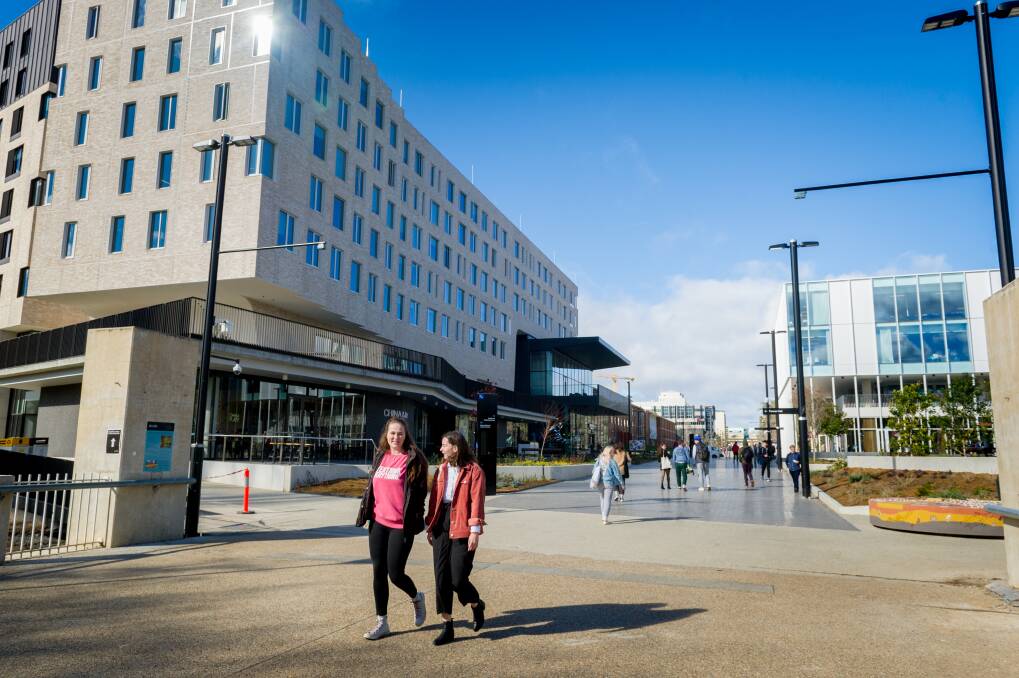
University campuses across the country have come back to life after being largely dormant last year to stem the spread of the COVID-19 virus.
Subscribe now for unlimited access.
or signup to continue reading
Students are able to come back for socially-distanced laboratories, workshops, tutorials and some smaller-scale lectures.
However, Australian universities are still managing the financial fallout of the pandemic as borders remain shut to new international students.
More job losses have been announced at some universities while others have cut costs through other measures.
Here's why universities are not out of the woods just yet.
Why are universities still hurting?
Peak body Universities Australia estimated the sector lost $1.8 billion in revenue in 2020, and revenue was expected to drop by $2 billion in 2021.
Australia has become a sought-after higher education destination, especially in the Asia-Pacific region. Unlike domestic students who qualify for a Commonwealth supported place, most international students are required to pay full-fees for their courses. This has become a lucrative income source for some universities. They use this revenue to subsidise research and other ongoing costs.
Data from the Department of Home Affairs shows there were 120,962 student visas granted across all education sectors in the six months to December 31, 2020. This is a drop of 39.8 per cent compared with the same period in the previous year.
There was a 32.5 per cent drop in visas granted for higher education, 82.2 per cent drop in English Language Intensive Course for Overseas Students (ELICOS), 27.9 per cent drop in postgraduate research and 24.6 per cent decrease in the VET sector.
But with borders still shut, visa-holders aren't able to get here to start their studies.
In 2018, an average of 26 per cent of university revenue came from fees from international students. That year universities spent $12.2 billion on research - $6 billion was from discretionary income, of which $3.1 billion was made up of international student fees.
The Australian government injected an additional $1 billion in research funding into universities in 2021 to help them cope with the financial pressures of COVID-19.
The extra cash was welcomed by the sector, however, the loss of revenue from international student fees will be felt for several years. When a student doesn't start in 2021, the impact will be felt for the duration of their degree.
Universities have been carefully reviewing their budgets to reduce overheads, leave liabilities and salary costs.
How many jobs have been lost?
Universities Australia found in a survey of its 39 member institutions that 17,300 jobs were lost in 2020. This was a head count of full-time, part-time and casual staff.
Universities have reduced their salary costs by making staff take their leave entitlements, offering voluntary redundancies and retirement packages and through forced redundancies.
Research-focused universities and ones which have a greater portion of international students have been hit harder.
Last week Charles Sturt University announced a restructure of academic disciplines into nine new schools, the loss of a further 4.1 full-time equivalent jobs and that 28.4 vacant full-time positions wouldn't be filled. The university is now confident it is on-track to balance the budget by the end of 2021, after recording a $50 million deficit in 2020.
This month the Australian National University released the last of its college change management plans as it estimates a $200 million operating deficit for 2020. A total of 467 staff will leave the ANU, through voluntary and involuntary separations, and 145 new positions will be added.
The University of Tasmania, which was heavily reliant on the Chinese international student market, ran a voluntary redundancy program and cut the number of courses from 514 to 120.
When will international students return?
There's no date for when international students will be allowed to enter Australia after the Australian government lowered the number of international arrivals, prioritising returning Australian residents over other visitors.
Various plans for a pilot scheme to bring students in on charter flights and house them in quarantine have been drafted but only one small scheme has managed to get off the ground.
In November last year, 63 Charles Darwin University students from China, Hong Kong, Japan, Vietnam and Indonesia arrived in Darwin and spent time in quarantine at the Howard Springs facility.
Other schemes to return students to Adelaide and Canberra were proposed last year but they were put on hold when COVID-19 case numbers flared up and internal borders were locked down.
READ MORE:
As the vaccine rollout gathers pace, the university sector is agitating for a plan to return international students.
One idea is to have a transit hub in Singapore where students could fly to connect to a charter flight.
Last year the ACT Chief Minister Andrew Barr put forward a plan to alternate planes of Australian residents and international students. He argued this was important for the territory's wider economy.
Some universities have offered discounted fees for new international students to start studying online while they are waiting for borders to reopen, including Murdoch University, Griffith University and Macquarie University.
The Department of Education, Skills and Employment released a protocol for international student arrivals. It states that preconditions for internationals students returning include:
- Internal state and territory borders must be open;
- Australians and permanent residents must not be disadvantaged;
- Students must be from a diverse range of countries; and
- The states, students and institutions are responsible for all travel and quarantine costs.
The fear in the Australian higher education sector is that if our borders don't open up soon, students will go elsewhere for their education, such as Canada or Europe, despite the higher health risks.
Our journalists work hard to provide local, up-to-date news to the community. This is how you can continue to access our trusted content:
- Bookmark canberratimes.com.au
- Download our app
- Make sure you are signed up for our breaking and regular headlines newsletters
- Follow us on Twitter
- Follow us on Instagram


